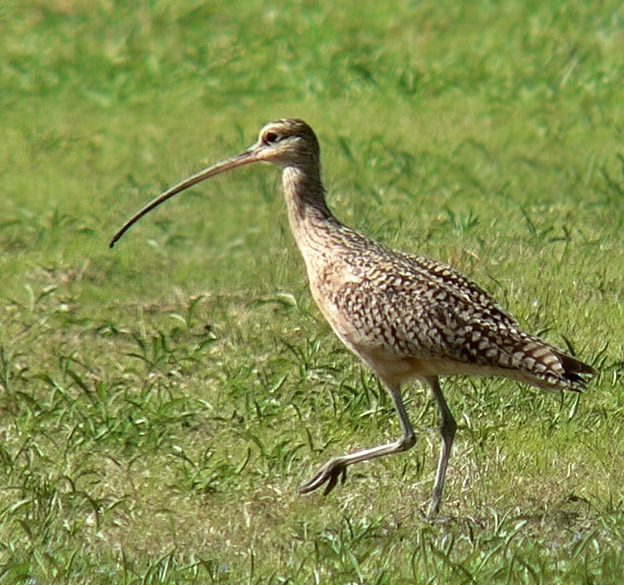
by John Shackford
The Long-billed Curlew (Numenius americanus), the largest of our shorebirds at 23 inches, was once a breeding bird over much of the prairies, and I am confident this would have included central Oklahoma; Bent (1964, Life Histories of North American Shore Birds, p. 98, Dover Publications, Inc., New York) said that this species “formerly bred over a large portion of central North America, including all of the prairie region, at least as far east as Michigan and Illinois, and probably Ohio.” In Oklahoma it is now restricted—as a breeding bird– to the western half of the Oklahoma Panhandle. I have been lucky enough to study the species extensively there, and would like to share some of the things I have observed about it.
In central Oklahoma, we see this curlew as a rare migrant during spring and fall; April and September are prime times to observe it here and Lake Hefner seems to provide the most records for our area. The female is slightly larger than the male, and I think I have found another clue to the sex identification of the bird that I have not seen reported in books elsewhere. The female has a long, symmetrically-curved bill, while the male has a slightly shorter bill that is mostly symmetrical but toward the end curves a little extra for the last couple inches or so, giving the bill a slightly “drooped-bill” appearance. This trait is not easily observed in isolation, but when you see 2 birds that really are a pair, the smaller bird with the “drooped bill-look” is probably the male. (Somebody correct me if you have evidence to the contrary.)
For those of you who travel to other parts of the state, you may find this curlew as a nesting bird in the western half of the Oklahoma Panhandle, and particularly in the eastern 3/4ths of Cimarron County. They seem to nest in small, loosely defined colonies and if you rile up one of the curlews in these small colonies, you are likely to rile up half a dozen or more.
I have found nests on quite bare cultivated fields. Something I suspect, but have never been able to prove, is that they often nest in growing wheat fields: I have seen adults go down there, but have not yet been able to find a nest in the growing wheat—the tall wheat is very difficult to survey. After the wheat is cut, I have frequently seen small young and adults in areas heavily dominated by wheat, again suggesting nesting there.
One of the most interesting things to me is how their behavior changes so drastically during the nesting season, depending on whether they are incubating eggs or protecting the precocial young that are out of the nest. While the adults are very quiet and “unassuming” before the eggs hatch, they change into vociferous flying protectors of the young after the eggs hatch. I don’t know the precise moment at which this change in behavior occurs—during egg pipping or after the young are out of the nest—but the change is very dramatic. One exception to this rule of being quiet on the nest may be when a raven flies by. I have seen a curlew shoot up from the ground—coming off a nest, I suspected—and give swift and determined chase to the raven.
These large brown birds are so confident of their cryptic coloration, that they will sometimes allow a person to touch them as they incubate their eggs, if one approaches very carefully and slowly. Steve Sherrod, of the Sutton Avian Research Center, and I both touched the back of a sitting bird on a nest in the western half of Cimarron County in 1986, Steve on one side and I on the other; the bird never flew.
Will the bird ever nest in central Oklahoma again? I heard a glimmer of hope, perhaps relevant to this—I think it was last year—when a possible nesting pair was reported on Ft. Sill in Lawton, Oklahoma. Strange things still happen in the bird world. According to G. M. Sutton’s “summaries of Oklahoma species [1982]” there were curlew nesting records, formerly, for about half a dozen counties in the western half of the main body of the state; the latest definite nesting record was for Ellis County, west-central Oklahoma, in 1906.
